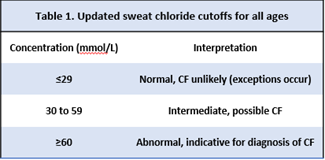In 2004 The New Yorker published an article about cystic fibrosis (CF) called “The Bell Curve” by Dr. Atul Gawande. Through the story of a little girl named Annie Page, the author highlights the progression of CF care. As a baby, Annie earned the name ‘Little Potato Chip’ because her skin was notably salty. An unremarkable detail to her family at the time. Annie was depicted as fine-boned and petite but otherwise healthy. However, her mother would sometimes hear Annie wheezing. The family was assured by Annie’s pediatrician that her petiteness was attributed to a family trait and no breathing problems were noted on examination. It wasn’t until Annie turned 3 years old and her growth fell to less than ninety-eight percent of girls her age that her pediatrician became deeply concerned. Following a slew of tests and a large differential, the pediatrician decided it was time to order a sweat chloride test. Annie’s results revealed a chloride concentration far higher than normal; Annie had CF.
Fortunately for Annie though, it was not 1938 when CF was first described. Back then children with CF died as infants and no screening or diagnostic tests were available. Flash forward to the 1990s when Annie was born and notable progress could be seen with the diagnosis and management of the disease. By the 90s, the sweat chloride test developed by Gibson and Cooke would be in use for more than 30 years and the cystic fibrosis conductance regulator (CFTR) protein would have been identified and the gene (CFTR) would be cloned soon after. Yet back then, not all states performed newborn screening for CF and Annie would be lucky to be alive for her 20th birthday - a big difference from 1938 but arguably progress still needed to be made.
Since Annie was born, there have been many changes and advances in CF diagnosis and management. Many guidelines, clinical databases and functional research are continuously updated to better understand CF so these patients could potentially live longer and lead more fulfilling lives. In our recent review article published in the journal of Clinical Chemistry, Dr. Stan Lo and I discuss the updates from the 2017 CF guidelines published by the CF Foundation as well as the dynamic landscape of CF testing and treatment. Critically important items for laboratorians to take note of include the updated sweat chloride cutoffs (Table 1), the Clinical and Functional Translation of CFTR (CFTR2) project (https://www.cftr2.org/) and the importance of multidisciplinary care for CF patients as the median age continues to get older and older.
In recent years, patients with CF are living longer. In fact, if Annie was born in the United States in 2013, her average life expectancy would be double what it was back in the 90s (40.6 years) or even longer if she was born in Canada (50.9 years). Older patients living with CF are benefiting from modern advancements in genetic sequencing, targeted therapies and other novel approaches too. In effect, just recently I came across the medical record of a 62 year old woman living with CF and thought – one day the Bell Curve could be superimposable with the non-CF population.

References
- Wiencek J, Lo SF. Advances in the diagnosis and management of cystic fibrosis in the genomic era. Clin Chem 2018;64(6):898-908.
- Gawande A. The Bell Curve. Annals of Medicine. The New Yorker, 2004. Accessed at https://www.newyorker.com/magazine/2004/12/06/the-bell-curve.